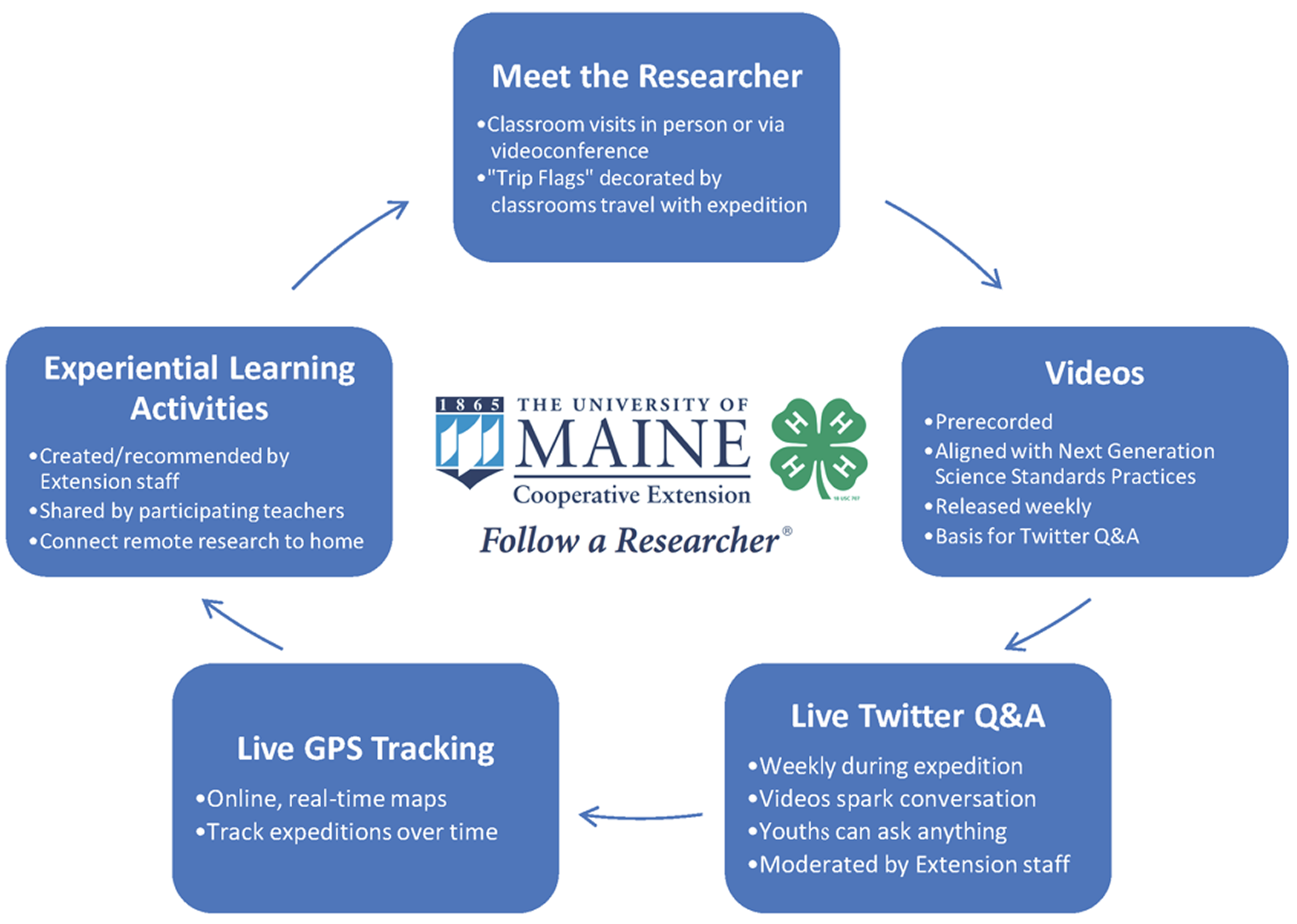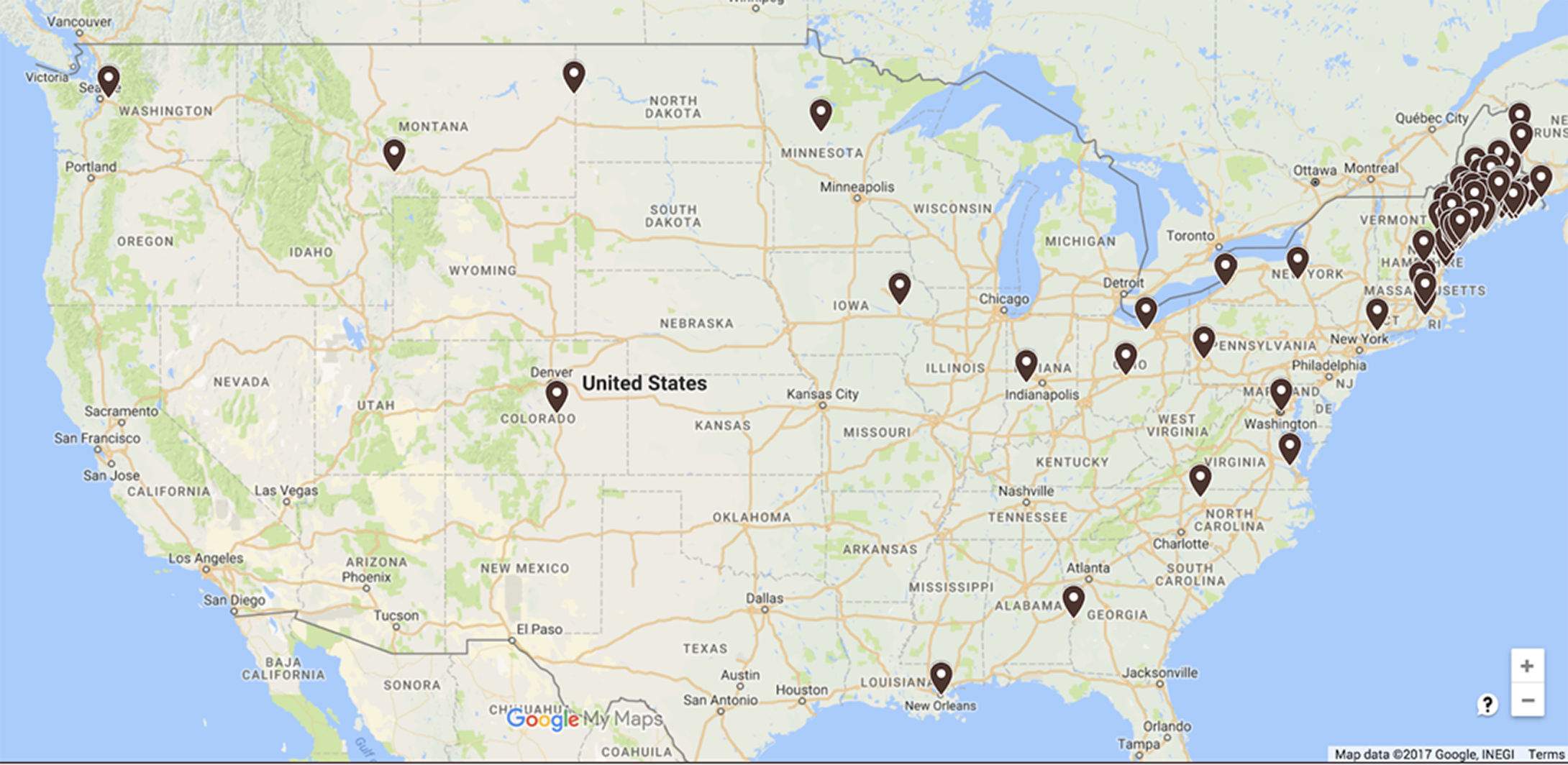 |
September
2018
|
September 2018 // Volume 56 // Number 5 // Tools of the Trade // v56-5tt3
Follow a Researcher: Using Innovative Technology to Connect Youths and Scientists
Abstract
Today's technology connects audiences to research-based knowledge and experts anywhere and at any time. Using social media allows Extension professionals to provide on-demand, asynchronous access to information. Synchronous, or real-time, interaction affords a more active and personal experience. The University of Maine has developed a program that facilitates live conversations between youths and graduate students conducting scientific research in remote locations around the world. This article describes a model for effectively using social media and satellite communication devices to engage kindergarten-through-grade-12 audiences with Extension in innovative ways.
Introduction
As Extension professionals, we aim to improve lives by connecting the public with research-based information. We are able to engage new audiences with the innovative use of technology (Seger, Hill, Stafne, & Swadley, 2017), which is imperative to keeping our programming accessible and relevant (Allen, Jolly, & Barnes, 2016; Meyer, Boyce, & Meyer, 2015). Given that 69% of Americans use social media to connect with others and access information (Pew Research Center, 2017), free web-based tools such as Twitter (with its format that allows members to create limited-character posts, or tweets) reduce barriers that have previously hindered connectivity and access to information.
Extension professionals' use of social media provides Extension clientele with instant access to up-to-date information and allows for the dissemination of asynchronous resources (e.g., reports, bulletins, videos) to almost any location (Gharis, Bardon, Evans, Hubbard, & Taylor, 2014). Synchronous, or real-time, platforms such as videoconferencing further the active engagement of target audiences (Lobley & Ouellette, 2017). Providing opportunities for live dialogue between experts and the public enables an open exchange of questions and answers, ideas, and concerns, fostering deeper connections between stakeholders and the research process (McCallie et al., 2009).
The University of Maine 4-H Follow a Researcher program uses social media and satellite communication to create real-time connections between youths and graduate student researchers from land-grant university campuses who are conducting scientific research in locations around the world. On the basis of our experience with that program, we describe herein a model for effectively using social media and satellite communication devices to engage kindergarten-through-grade-12 (K-12) audiences with Extension in innovative ways.
Synchronous Engagement Tools
Although in-person expert–audience interaction is preferred, live videoconferencing allows for a virtual face-to-face experience, provides the ability to reach more people, and mitigates distance barriers (Augestad & Lindsetmo, 2009; Lobley & Ouellette, 2017). Platforms such as Zoom, Google Hangouts, and Skype provide easy-to-use tools for simultaneously connecting participants in multiple locations.
Satellite communication devices, such as the Garmin inReach Explorer, allow users to connect to the Internet from anywhere on the planet without reliance on cellular or Wi-Fi service. The satellite communicator broadcasts GPS data to the web, enabling audiences to track an expert's position in real time. The device sends and receives 140-character messages via email, text messaging, and social media posting. These short messages make Twitter an ideal platform for conducting real-time question-and-answer sessions. (For more information on the Garmin inReach Explorer, go to https://explore.garmin.com/en-US/inreach.)
Synchronous Engagement Through Follow a Researcher
The program model for Follow a Researcher (Figure 1) highlights opportunities for participants to interact with University of Maine graduate student scientists, offering a glimpse of cutting-edge research in action. Live conversations focus on the expert's research but often include youth-generated questions about the larger context of a project, including local geography, culture, and working conditions. Videoconferencing tools permit virtual face-to-face interactions between youths and the researcher when an Internet connection is available. Researchers in remote field sites engage audiences by using the Garmin inReach Explorer to send and receive tweets and to share their locations via online maps.
Figure 1.
Follow a Researcher Program Model

Engagement Results
More than 200 K-12 educators and 7,000 youths from 18 states have participated in four University of Maine 4-H Follow a Researcher expeditions since 2015 (Figure 2). K-12 educators report use of both synchronous and asynchronous resources. The integration of Follow a Researcher into classrooms ranges from use as a supplement for gifted and talented programs to multiple-classroom/whole-grade engagement through multidisciplinary language arts, social studies, mathematics, and science projects.
Figure 2.
Follow a Researcher Participants, 2015–2017

Insights and Recommendations
Simply applying a tool does not guarantee its utility or effectiveness in meaningful audience engagement. The design process is of critical importance when developing organizational social media accounts (Robideau & Santl, 2011). Recommendations for successfully integrating social media and satellite communication technologies are as follows:
- Use password protection to restrict access to registered participants. Doing so allows you to collect contact information for subsequent program evaluation.
- Monitor for inappropriate communication. The nature of a live social media experience allows the general public to comment.
- Create a backup plan in case technology fails and live communication with the expert is lost.
- Ensure access to high-speed, reliable Internet connections for all participants to optimize videoconference quality.
- Create a program-related Twitter handle for the researcher to use instead of his or her personal handle. Applying this approach allows you to avoid exposing the audience to individual beliefs or opinions that may conflict with those of Extension or program participants.
- Provide both synchronous and asynchronous opportunities for engagement. Allow for questions to be submitted ahead of time via email, and post all answers online after the live interaction. A fully disconnected version of the experience should be available for audiences for whom real-time connections are not possible.
- Activate the satellite communication device only for the duration of a program. The device requires a monthly subscription fee.
- Communicate early with K-12 educators, administrators, and school technology staff to test technology and request social media access. Approximately 41% of schools lack high-speed connectivity (Federal Communications Commission, 2016), and schools' social media sites may be blocked.
Conclusion
Extension must be innovative in its programming to remain vital (Meyer et al., 2015). Although there can be challenges and barriers to using social media and satellite communication technology, our audience can benefit when Extension staff use online networking tools (Kinsey, 2010). Satellite communications and Twitter connect audiences with resources and people from around the globe. A combination of synchronous and asynchronous resources allows more participants to use the resources and engage with their local land-grant universities. Follow a Researcher demonstrates how a combination of intentionally deployed tools creates an experience greater than the sum of its parts. We attribute the success of this model not to using a tool for the sake of its novelty but to thoughtful program design that best meets the needs of our audiences, thus increasing the reach and relevance of Extension.
References
Allen, K., Jolly, C., & Barnes, J. (2016). Using social media to engage and educate teen parents. Journal of Extension, 54(2), Article 2TOT3. Available at: https://www.joe.org/joe/2016april/tt3.php
Augestad, K. M., & Lindsetmo, R. O. (2009). Overcoming distance: Video-conferencing as a clinical and educational tool among surgeons. World Journal of Surgery, 33(7), 1356–1365. doi:10.1007/s00268-009-0036-0
Federal Communications Commission. (2016). 2016 broadband progress report. (FCC Publication No. 16-6). Retrieved from https://apps.fcc.gov/edocs_public/attachmatch/FCC-16-6A1.pdf
Gharis, L. W., Bardon, R. E., Evans, J. L., Hubbard, W. G., & Taylor, E. (2014). Expanding the reach of Extension through social media. Journal of Extension, 52(3), Article 3FEA3. Available at: http://www.joe.org/joe/2014june/a3.php
Kinsey, H. (2010). Five social media tools for the Extension toolbox. Journal of Extension, 48(5), Article 5TOT7. Available at: http://www.joe.org/joe/2010october/tt7.php
Lobley, J., & Ouellette, K. L. (2017). Using videoconferencing to create authentic online learning for volunteers. Journal of Extension, 55(5), Article 5TOT8. Available at: https://www.joe.org/joe/2017october/tt8.php
McCallie, E., Bell, L., Lohwater, T., Falk, J. H., Lehr, J. L., Lewenstein, B. V., . . . Wiehe, B. (2009). Many experts, many audiences: Public engagement with science and informal science education. Retrieved from http://www.informalscience.org/sites/default/files/PublicEngagementwithScience.pdf
Meyer, N. J., Boyce, S. P., & Meyer, R. L. (2015). A call to embrace program innovation. Journal of Extension, 53(3), Article 3COM1. Available at: https://www.joe.org/joe/2015june/comm1.php
Pew Research Center. (2017). Social media fact sheet. Retrieved from
http://www.pewinternet.org/fact-sheet/social-media/
Robideau, K., & Santl, K. (2011). Strengthening 4-H program communication through technology. Journal of Extension, 49(6), Article 6TOT2. Available at: http://www.joe.org/joe/2011december/tt2.php
Seger, J., Hill, P., Stafne, E., & Swadley, E. (2017). Twitter chats: Connect, foster, and engage internal Extension networks. Journal of Extension, 55(2), Article 2TOT3. Available at: https://www.joe.org/joe/2017april/tt3.php





